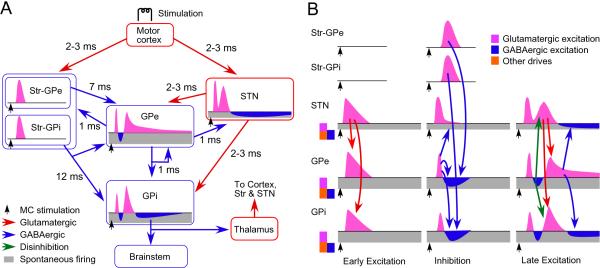Figure 1.
A: Diagrams show major synaptic connections form the motor cortex to GPi. B: Diagrams show major synaptic driving forces evoking an early excitation, an inhibition, and a late excitation in GPe and GPi after cortical stimulation. The diagrams are based on the suggestions obtained from previous studies (Nambu et al., 2000, Kita et al., 2004, Kita, 2007, Tachibana et al., 2008). The level of background activity of pallidal and STN neurons are controlled by glutamatergic, GABAergic, and other driving forces including autonomous firing and slow acting neuroactive substances. The motor cortex provides strong inputs to Str and STN. Stimulation of the motor cortex induces a shorter latency excitation in STN than Str. The difference in the excitation latencies in Str and STN produces an early excitation-inhibition sequence in many pallidal neurons. The early excitation in STN evokes an early excitation in GPe and GPi. The Cx-STN-GPe and Cx-Str pathways provide the main sources for the inhibition in STN, GPe, and GPi. The late excitation in STN, which may be due to various mechanisms including the disinhibition from GPe, provides the main source for the late excitation in GPe and GPi.

